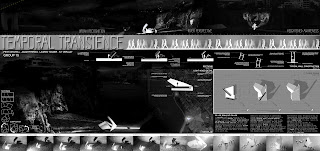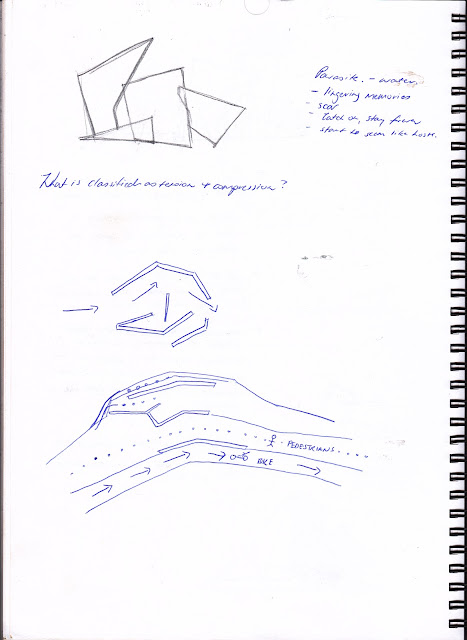Reading 3 - What is home?
Building, dwelling, thinking (Martin Heidegger)
Consider: Dwelling
Consider: Building
Ask: "What is it to dwell?"
Ask: "How does building belong to dwelling"?
Dwelling and building = activities which are separate
Ask: "In what way does building belong to dwelling"?
I found the example of the bridge given by Heidegger to understand this concept.
A bridge is a built thing. Is it a building? It is built, it is constructed, people do not dwell here, people do not dwell in a market, in a railway statoipm, power station or stadium. It is not a dweling. It is a building.
When a bridge bounds two objects, two pieces of land its prupose is to bring those pieces of land together, its design causes those two spaces to now lie across from one another. The bridge has brought together the water, the bank, the land and unified them as one. I like this idea Heidegger proposes (it is an obvious one once realised but often I find I do not think this way) he states: something that is itself an actual location, only that thing has the ability to make a space a site. Before the bridge was created there was no location. Instead Heidegger claims that "a location comes into existence only by virtue of the bridge" (52).
I can apply this to a house or to our folie. Before we designed the folie this was Howard Smith Wharves, a very lange all encomapssing space. If we were to build a folie off of the jetty in the corner under the cliff, suddenly the space becomes a site. The site of the folie.
A hill was just space before a house was built. Once that house was built the space became a site. The site of the house. The house is a location. The bridge is a location. Our folie, a location.
Spaces which we pass through on a daily basis are provided to us by locations. The nature of the spaces we pass through is rooted in the type of buildings that constiute the nature of the location. Therfore, space cannot be external nor internal, nor can the experience of space be any of those things.
Spaces = let into by the dwelling of humans
I also appreciate this next example:
"When I go towards the door of the lecture hall, I am already there, and I could not go to it at all if I were not such that I am there. I am never here only, as this encapsulated body; rather, I am there, that is, I already pervade the room, and only thus can I go thorugh it" (53).
Basically, your body is not a single thing, there is always a relationship between your body and a space. You must occupy that space to be there, but you do not need to be inside the room to get inside it. You approach it from the previous space, it is the act of dwelling. You are in one space to pass onto another, you are never only just in your body.Now you are in a location.
If we as humans are able to dwell, then we are able to build and understand that there is a relationship between dwelling, being in a space, understanding that space's purpose for dwelling, then we can build.
A home is not a house - Reyner Banham
Mehcanical services of a house - piping, ducting, lights, wires, inlets, outlets, antennae, conduits, freezers, heaters, flues and other complex hardware.
Banham claims architects are wary of services and the implications of services on a building. Seen by architects as a cultural threat. Banham also claims services are treated with causion as they are too new to have been properly worked into cohesively, with the wisdom and vision of architecture. He discusses this is relation to the qualities of house and home. I understand this to be the qualities of a building, a plain old buliding, and a house which has distinct and cherished characteristics.
Banham addresses briefly the issue of privacy.
Claims - Americans prefer suburbs.
He discusses controlled and uniform environments, claiming controlled enivronments are places in which the inhabitant has the power to make changes to his or her level of comfort. Whereas a uniform environment is an environment in which the user has limited control because parametres have already been set.
Finally, I appreciate this one idea laid out by Banham
The idea that a house, like a body is not a single entity. It does not live in its own little world and even if it did it would still not be alone as it would be occupying additional space. Banham suggests that a house or a home is a service core set in infinite space in which it is a small part of the "Great Out There". I take this to mean that he sees a house,home, building as something that is built and then encompasses views, air, surrouding noises, space, colours ect. It does not just rest on its own unimpeded, neither does the surrounding space sit there unhindered.
Reflection/Application:
FOLIE!
Folie according to Banham's principles does not stop activating space as soon as you exit its 5x5x5 bounding box. The FOLIE is in itself a core, perhaps with less services as Banham originally listed but never the less a core in which a location (as Heidegger mentioned) is created. Its presence, its building creates a location. Within that building, within that location the 5x5x5 is obstructed by views, by sounds, smells, colours, spaces, topography ect. The FOLIE no matter how neatly packaged within its little 5x5x5 box is always going to have a relationship with the site - the site that was created by its building and the spaces between the site that man can occupy are now also present. The FOLIE is now not a drawing, not a building but is a folie which sits within a bigger picture.





 Second Diagram
Second Diagram
















.jpg)

.jpg)





















.jpg)

.jpg)
.jpg)






